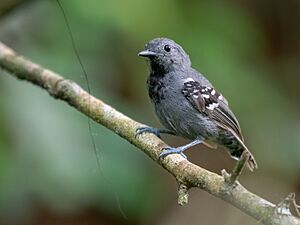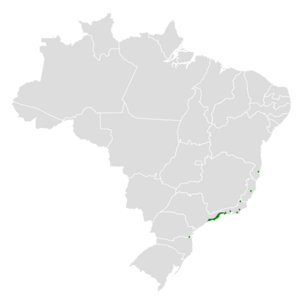Salvadori's antwren facts for kids
Quick facts for kids Salvadori's antwren |
|
|---|---|
 |
|
| Conservation status | |
| Scientific classification | |
| Genus: |
Myrmotherula
|
| Species: |
minor
|
 |
|
The Salvadori's antwren (scientific name: Myrmotherula minor) is a small bird that lives only in Brazil. It belongs to a group of birds called "typical antbirds." This bird is special because it is found nowhere else in the world.
Contents
About the Salvadori's Antwren Name
The Salvadori's antwren is a unique species, meaning it doesn't have different subspecies. It is similar to the Rio Suno antwren and the slaty antwren. These birds look, act, and sound alike.
This bird is named after Tommaso Salvadori. He was an Italian expert who studied animals and birds. He was the first person to describe this bird.
What Does the Salvadori's Antwren Look Like?
The Salvadori's antwren is about 9 centimeters (3.5 inches) long. It is a small bird with a short tail.
Male Antwren Appearance
Adult male antwrens are mostly gray. Their belly and chest are lighter gray. Their tail is gray with a black band near the end. The tips of their tail feathers are white. Their wings are gray with blackish feathers that have white tips. The male's throat and the middle of its upper chest are black. The feathers under its tail have blackish stripes.
Female Antwren Appearance
Adult female antwrens have a gray head. Their upper body is olive-brown. Their tail and wings are a dull reddish-brown color. The tail feathers have reddish edges. The wing feathers have thin buff (pale yellowish-brown) edges. The female's throat is a dull white. The rest of her belly and chest are a deep buff color. This color is strongest on her sides and under her tail. Young male antwrens do not have the black band on their tail.
Where Does the Salvadori's Antwren Live?
The Salvadori's antwren lives in the Atlantic Forest of Brazil. It is found in specific, small areas along the coast. These areas are between the states of Bahia and the very northeastern part of Santa Catarina.
Antwren Habitat Preferences
This bird lives in the lower and middle parts of the forest. It prefers evergreen forest and older secondary forest (forest that has grown back). It likes to stay deep inside the forest. It is often found near running water. Most of these birds live below 500 meters (1,600 feet) in elevation. However, some can be found as high as 900 meters (3,000 feet).
Antwren Behavior
Movement and Home
The Salvadori's antwren is thought to live in the same area all year round. It does not migrate.
What Does the Salvadori's Antwren Eat?
We don't know exactly what the Salvadori's antwren eats. But it probably eats mostly insects and spiders. It looks for food alone, in pairs, or with its family. It often joins mixed-species feeding flocks with other types of birds.
It usually searches for food around the tops and edges of trees. These trees have medium to large leaves. It mostly feeds between 4 and 8 meters (13 to 26 feet) above the ground. But it can go as low as 1 meter (3 feet) or as high as 12 meters (39 feet). It finds prey by picking it off live leaves. It also takes prey from dead leaves, moss, and hanging Usnea lichen.
Reproduction and Life Cycle
We know that the Salvadori's antwren breeds in October. But we don't know much else about its breeding habits.
Antwren Sounds and Calls
The song of the Salvadori's antwren is a "short twittering" sound. It starts very high and then has a liquid "tyweet-tweet-tueet" sound. Its calls include short whistles, sharp chips, and longer series of chips.
Protecting the Salvadori's Antwren
The IUCN (International Union for Conservation of Nature) first listed the Salvadori's antwren as "Threatened" in 1988. Since 1994, it has been listed as "Vulnerable." This means it is at risk of becoming endangered.
Why is the Antwren Vulnerable?
The Salvadori's antwren lives in a small area. This area is also broken up into many small pieces. Experts believe there are only 2,500 to 10,000 adult birds left. This number is thought to be going down. The biggest danger to this bird is habitat destruction. This means its forest home is being cut down.
Most of the lowland Atlantic forest has been destroyed. This includes areas where the antwren used to live. Even some protected areas where it lives are not safe. The bird is considered uncommon to rare and found only in certain places. It does live in some protected areas. However, many of these areas do not have enough forest at the right elevation (below 300 meters or 980 feet) for the bird to thrive.


